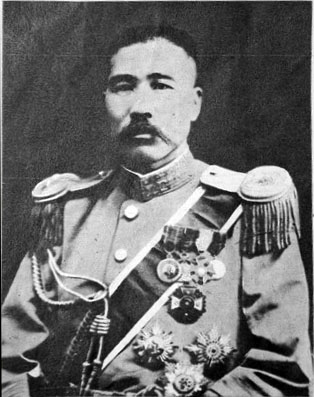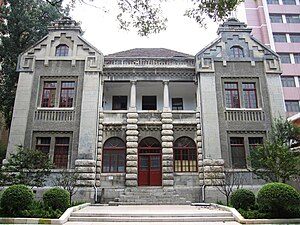
The Chinese Civil War was fought between the Kuomintang-led government of the Republic of China and the forces of the Chinese Communist Party, with armed conflict continuing intermittently from 1 August 1927 until 7 December 1949, resulting in a Communist victory and subsequent control of mainland China.

The Northern Expedition was a military campaign launched by the National Revolutionary Army (NRA) of the Kuomintang (KMT) against the Beiyang government and other regional warlords in 1926. The purpose of the campaign was to reunify China, which had become fragmented in the aftermath of the Revolution of 1911. The expedition was led by Generalissimo Chiang Kai-shek, and was divided into two phases. The first phase ended in a 1927 political split between two factions of the KMT: the right-leaning Nanjing faction, led by Chiang, and the left-leaning faction in Wuhan, led by Wang Jingwei. The split was partially motivated by Chiang's Shanghai Massacre of Communists within the KMT, which marked the end of the First United Front. In an effort to mend this schism, Chiang Kai-shek stepped down as the commander of the NRA in August 1927, and went into exile in Japan.

Feng Yuxiang, courtesy name Huanzhang (焕章), was a Chinese warlord and a leader of the Republic of China from Chaohu, Anhui. He served as Vice Premier of the Republic of China from 1928 to 1930. He was also known as the "Christian General" for his zeal to convert his troops and the "Traitorous General" for his penchant to break with the establishment. In 1911 he was an officer in the ranks of Yuan Shikai's Beiyang Army but joined forces with revolutionaries against the Qing dynasty. He rose to high rank within Wu Peifu's Zhili warlord faction but launched the Beijing Coup in 1924 that knocked Zhili out of power and brought Sun Yat-sen to Beijing. He joined the Nationalist Party (KMT), supported the Northern Expedition and became blood brothers with Chiang Kai-shek, but resisted Chiang's consolidation of power in the Central Plains War and broke with him again in resisting Japanese incursions in 1933. He spent his later years supporting the Revolutionary Committee of the Kuomintang.
This article is concerned with the events that preceded World War II in Asia.

The defense of the Great Wall was a campaign between the armies of Republic of China and Empire of Japan, which took place before the Second Sino-Japanese War officially commenced in 1937 and after the Japanese invasion of Manchuria in 1931. It is known in Japanese as Operation Nekka and in many English sources as the First Battle of Hopei.

The Warlord Era was a period in the history of the Republic of China when control of the country was divided among former military cliques of the Beiyang Army and other regional factions from 1916 to 1928.

The Nationalist government, officially the National Government of the Republic of China, also known as the Second Republic of China or simply as the Republic of China, refers to the government of the Republic of China from 1 July 1925 to 20 May 1948, led by the Kuomintang.

The Central Plains War was a series of military campaigns in 1929 and 1930 that constituted a Chinese civil war between the Nationalist Kuomintang government in Nanjing led by Generalissimo Chiang Kai-shek and several regional military commanders and warlords who were former allies of Chiang.

The Second United Front was the alliance between the ruling Kuomintang (KMT) and the Chinese Communist Party (CCP) to resist the Japanese invasion of China during the Second Sino-Japanese War, which suspended the Chinese Civil War from 1937 to 1945.

The Huanggutun incident, also known as the Zhang Zuolin Explosion Death Incident, was the assassination of the Fengtian warlord and Generalissimo of the Military Government of China Zhang Zuolin near Shenyang on 4 June 1928.

The Northeast Flag Replacement refers to Zhang Xueliang's announcement on 29 December 1928 that all banners of the Beiyang government in Manchuria would be replaced with the flag of the Nationalist government, thus nominally uniting China under one government.

Shi Yousan was a Chinese general of the National Revolutionary Army who served as the 9th Governor of the Chahar and 3rd Governor of Anhui provinces during the Republican era of China.

The Republic of China (ROC), or simply China, was a sovereign state based on mainland China from 1912 to 1949 prior to the Government of the Republic of China's relocation to Taiwan, where it continues to be based today. The ROC was established on 1 January 1912 during the Xinhai Revolution against the Qing dynasty, ending the imperial history of China. The ROC's government was ruled by the Kuomintang as a one-party state based in Nanjing from 1927, until its flight to Taipei on 7 December 1949 following the KMT's de facto defeat by the Chinese Communist Party (CCP) in the Chinese Civil War. The CCP-led People's Republic of China (PRC) was established in mainland China upon its official proclamation on 1 October 1949, while the ROC retains actual control over the Taiwan Area with the political status of Taiwan remaining in dispute to this day.

The Chinese Communist Revolution was a social and political revolution that culminated in the establishment of the People's Republic of China in 1949. For the preceding century, China had faced escalating social, economic, and political problems as a result of Western imperialism, Japanese imperialism, and the decline of the Qing dynasty. Cyclical famines and an oppressive landlord system kept the large mass of rural peasantry poor and politically disenfranchised. The Chinese Communist Party (CCP) was formed in 1921 by young urban intellectuals inspired by European socialist ideas and the success of the Bolshevik Revolution in Russia. The CCP originally allied itself with the nationalist Kuomintang party against the warlords and foreign imperialist forces, but the Shanghai Massacre of Communists ordered by Kuomintang (KMT) leader Chiang Kai-shek in 1927 forced them into the Chinese Civil War spanning more than two decades.
Events in the year 1928 in China.

Hikosuke Fukuda was a lieutenant-general in the Imperial Japanese Army. He is best known for his involvement in the Jinan Incident.

The Warlord Rebellion in northeastern Shandong was an uprising of several allied Chinese warlord armies under the leadership of Zhang Zongchang in 1929. The rebels wanted to regain their former territories in Shandong from Liu Zhennian, the man who had defected from Zhang to the Nationalist government in Nanjing during the Northern Expedition. After some initial successes, the rebels were defeated due to the indiscipline of their forces. In the end, the uprising failed to topple Liu Zhennian's rule over eastern Shandong, but resulted in high civilian casualties and widespread destruction at the hands of both sides in the conflict.

The Wuhan Nationalist government, also known as the Wuhan government, Wuhan regime, or Hankow government, was a government dominated by the left-wing of the Nationalist or Kuomintang (KMT) Party of China that was based in Wuhan from 5 December 1926 to 21 September 1927, led first by Eugene Chen, and later by Wang Jingwei.

The National Pacification Army (NPA), also known as the Anguojun or Ankuochun, was a warlord coalition led by Fengtian clique General Zhang Zuolin, and was the military arm of the Beiyang government of the Republic of China during its existence.

Lieutenant General Sasaki Tōichi was a Japanese soldier who served in the Imperial Japanese Army. He was known as an expert on Chinese affairs, had close relationships with leading figures in the Kuomintang (KMT)'s National Revolutionary Army during the 1920s, and expressed sympathy for their cause. A violent encounter with KMT forces during the 1928 Jinan incident, however, led him to abandon his pro-KMT stance, and adopt a pessimistic attitude toward China. He later served as chief military advisor to the Japanese puppet state Manchukuo, and during the Second Sino-Japanese War, he was involved in perpetrating the Nanjing massacre. In the last days of the Second World War, Sasaki was captured by Soviet troops and handed over to the Chinese communists, who interned him at the Fushun War Criminals Management Centre, where he died in 1955. He was a prolific writer, and left detailed accounts of his experiences in China.






















